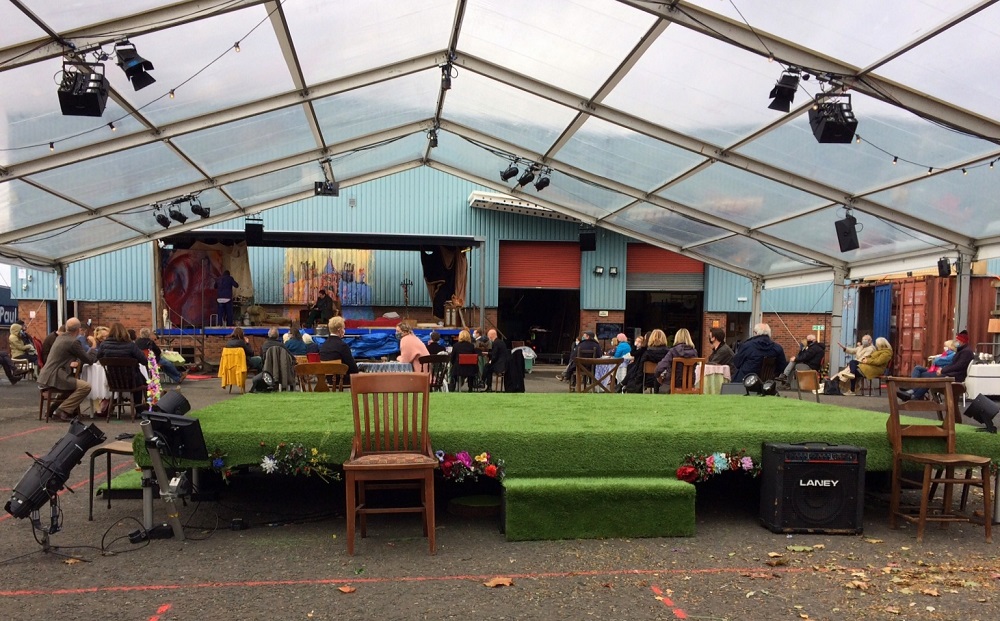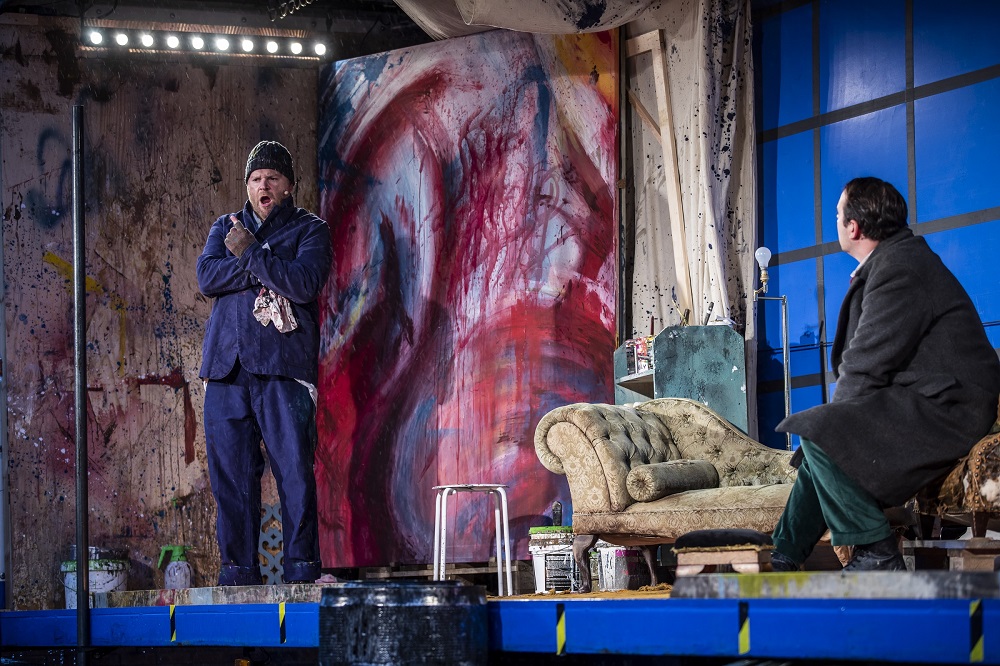La bohème, Scottish Opera – pandemic Puccini | reviews, news & interviews
La bohème, Scottish Opera – pandemic Puccini
La bohème, Scottish Opera – pandemic Puccini
Top-quality cast and players put on a potted version in a parking lot
Picture the scene. A vast steel gazebo covers a nondescript parking lot next to an industrial unit in Glasgow. With a clear plastic covering, it is the most rudimentary of shelters, sides open to admit the roar of the M8 and the wailing of sirens, carried on a keen autumnal breeze.
Without preamble, loud music begins. It turns out that the figures in the building are an orchestra, the men on the truck are the poet Rodolfo (Samuel Sakker) and the painter Marcello (Roland Wood), and this is Puccini’s La bohème performed by Scottish Opera in the age of Coronavirus (general view of the set up pictured below by Christopher Lambton). After five months in the shadows, the company has just started the painful process of trying to perform to live audiences while adhering to restrictions and the best interpretations of safe performance practice. For this first night, there were almost as many front of house staff as there were people in the audience: everyone guided to allocated seats grouped in “pods”, contact-free ticketing, wipeable programme notes, sanitiser everywhere. It seemed busy and bustling but the numbers are sobering: with just six performances in all, this production will reach only 600 people at £20 a ticket, compared to the thousands that would cheerfully pay £60 for this opera in Glasgow’s Theatre Royal or the Edinburgh Festival Theatre. At the same time the company is launching a series of free “Pop Up Opera” shows – bits of The Gondoliers and Don Giovanni – that run all over Scotland for the rest of this month. 
Publicity material described the production, directed by Roxana Haines, as “inspired by the current pandemic”, but thankfully she steered clear of too many cheap laughs, the main comic vehicle being the upstaging antics of the dancer-actor Jessica Rhodes. As the officious waitress at Café Momus, set on the central stage, she was liberal with her clipboard and air freshener while flirting outrageously with Schaunard (Arthur Bruce) from behind face mask and visor. Some ad libs: “mind you don’t touch the handrail!” and “If I dance I’ll need to sanitise” were presumably not in Amanda Holden’s original translation but did not intrude. Rhian Lois was cheerfully over the top as the mercenary Musetta, though her waltz number could have been less brash and a shade more seductive. 
I spent this short evening very much in two minds. On the one hand I was in awe of the massive effort required to bring this show to life: the construction of the gazebo, conversion of the trucks, the installation of the spider’s web of wiring for amplification, lighting and TV monitors, the adaptation to crazily unfamiliar rehearsal and performance conditions. It is a credit to the company that they set themselves this challenge and rose to it magnificently. But part of me was reluctant to accept that this was really opera, and that this might be the closest we get for some time to the traditional collective experience of more than a thousand people in a theatre. Suspension of disbelief is difficult when a raw wind is whipping around your neck. Having said that, I was deeply moved by the staging at the very end of the opera. Unable to clasp Mimi in her dying moment, Rodolfo stood still, clearly heartbroken and at a loss. Onto the stage at this moment came Jessica Rhodes, now dressed as a doctor, to give him a tender embrace through layers of PPE. It brought the real world of Covid-19 onto the operatic stage with heartfelt insight.
The future of Arts Journalism
You can stop theartsdesk.com closing!
We urgently need financing to survive. Our fundraising drive has thus far raised £49,000 but we need to reach £100,000 or we will be forced to close. Please contribute here: https://gofund.me/c3f6033d
And if you can forward this information to anyone who might assist, we’d be grateful.

Subscribe to theartsdesk.com
Thank you for continuing to read our work on theartsdesk.com. For unlimited access to every article in its entirety, including our archive of more than 15,000 pieces, we're asking for £5 per month or £40 per year. We feel it's a very good deal, and hope you do too.
To take a subscription now simply click here.
And if you're looking for that extra gift for a friend or family member, why not treat them to a theartsdesk.com gift subscription?
more Opera
 La bohème, Opera North review - still young at 32
Love and separation, ecstasy and heartbreak, in masterfully updated Puccini
La bohème, Opera North review - still young at 32
Love and separation, ecstasy and heartbreak, in masterfully updated Puccini
 Albert Herring, English National Opera review - a great comedy with depths fully realised
Britten’s delight was never made for the Coliseum, but it works on its first outing there
Albert Herring, English National Opera review - a great comedy with depths fully realised
Britten’s delight was never made for the Coliseum, but it works on its first outing there
 Carmen, English National Opera review - not quite dangerous
Hopes for Niamh O’Sullivan only partly fulfilled, though much good singing throughout
Carmen, English National Opera review - not quite dangerous
Hopes for Niamh O’Sullivan only partly fulfilled, though much good singing throughout
 Giustino, Linbury Theatre review - a stylish account of a slight opera
Gods, mortals and monsters do battle in Handel's charming drama
Giustino, Linbury Theatre review - a stylish account of a slight opera
Gods, mortals and monsters do battle in Handel's charming drama
 Susanna, Opera North review - hybrid staging of a Handel oratorio
Dance and signing complement outstanding singing in a story of virtue rewarded
Susanna, Opera North review - hybrid staging of a Handel oratorio
Dance and signing complement outstanding singing in a story of virtue rewarded
 Ariodante, Opéra Garnier, Paris review - a blast of Baroque beauty
A near-perfect night at the opera
Ariodante, Opéra Garnier, Paris review - a blast of Baroque beauty
A near-perfect night at the opera
 Cinderella/La Cenerentola, English National Opera review - the truth behind the tinsel
Appealing performances cut through hyperactive stagecraft
Cinderella/La Cenerentola, English National Opera review - the truth behind the tinsel
Appealing performances cut through hyperactive stagecraft
 Tosca, Royal Opera review - Ailyn Pérez steps in as the most vivid of divas
Jakub Hrůša’s multicoloured Puccini last night found a soprano to match
Tosca, Royal Opera review - Ailyn Pérez steps in as the most vivid of divas
Jakub Hrůša’s multicoloured Puccini last night found a soprano to match
 Tosca, Welsh National Opera review - a great company reduced to brilliance
The old warhorse made special by the basics
Tosca, Welsh National Opera review - a great company reduced to brilliance
The old warhorse made special by the basics
 BBC Proms: The Marriage of Figaro, Glyndebourne Festival review - merriment and menace
Strong Proms transfer for a robust and affecting show
BBC Proms: The Marriage of Figaro, Glyndebourne Festival review - merriment and menace
Strong Proms transfer for a robust and affecting show
 BBC Proms: Suor Angelica, LSO, Pappano review - earthly passion, heavenly grief
A Sister to remember blesses Puccini's convent tragedy
BBC Proms: Suor Angelica, LSO, Pappano review - earthly passion, heavenly grief
A Sister to remember blesses Puccini's convent tragedy
 Orpheus and Eurydice, Opera Queensland/SCO, Edinburgh International Festival 2025 review - dazzling, but distracting
Eye-popping acrobatics don’t always assist in Gluck’s quest for operatic truth
Orpheus and Eurydice, Opera Queensland/SCO, Edinburgh International Festival 2025 review - dazzling, but distracting
Eye-popping acrobatics don’t always assist in Gluck’s quest for operatic truth

Add comment